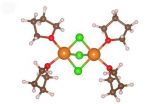(Press-News.org) Lithium (Li)-ion batteries serve us well, powering our laptops, tablets, cell phones and a host of other gadgets and devices. However, for future automotive applications, we will need rechargeable batteries with significant increases in energy density, reductions in cost and improvements in safety. Hence the big push in the battery industry to develop an alternative to the Li-ion technology.
One promising alternative would be a battery based on a multivalent ion, such as magnesium (Mg). Whereas a Li-ion with a charge of +1 provides only a single electron for an electrical current, a Mg-ion has a charge of +2, which means Mg-ions, in principle, can provide twice the electrical current of Li-ions if present with the same density. Mg-ion batteries would also be safer and less expensive than Li-ion batteries. However, the additional charge on a multivalent ion creates other problems that have hampered the development of Mg-ion batteries. This situation may soon change thanks to new findings from the U.S. Department of Energy (DOE)'s Lawrence Berkeley National Laboratory (Berkeley Lab) as part of the Joint Center for Energy Storage Research (JCESR), a DOE Energy Innovation Hub.
David Prendergast and Liwen Wan, scientists working in the Theory of Nanostructured Materials group at the Molecular Foundry, a DOE nanoscience research facility hosted by Berkeley Lab, ran a series of computer simulations that dispelled a long-standing misconception about Mg-ions in the electrolyte that transports the ions between a battery's electrodes.
"The catch for multivalent ions is that their increased charge draws more attention to them – they become surrounded in the battery's electrolyte by other oppositely charged ions and solvent molecules – which can slow down their motion and create energetic penalties to exiting the electrolyte for the electrodes," says Prendergast. "However, we found the problem may be less dire than is widely believed."
Based on X-ray absorption experiments with Mg-containing solids, such as the salt magnesium chloride, and crystals derived from the class of working electrolytes used for Mg-based batteries (dichloro-complex solutions), it has been assumed that Mg-ions are surrounded (or strongly coordinated) by six nearest neighbors, which could be counter-ions, such as chlorides, or solvent molecules, in this case tetrahydrofuran. This bulky six-fold coordination sphere would make it difficult for Mg-ions to move through a battery, if it were also present in the liquid electrolyte. Running first-principles molecular dynamics simulations on the supercomputers at Berkeley Lab's National Energy Research Scientific Computing Center (NERSC), as well as the Vulcan computer cluster system at the Molecular Foundry, Prendergast and Wan found that Mg-ions are coordinated by only four nearest neighbors in the electrolyte.
"This is good news for Mg-based batteries, since it means that there are less species to carry around and shed as the battery undergoes discharging or charging," Prendergast says. "Our findings also suggest that the performance bottlenecks experienced with Mg-ion batteries to date may not be so much related to the electrolyte itself, but to what happens at the interface between the electrolyte and electodes as the Mg-ions shed their coordination spheres."
Prendergast and Wan have published the results of their work in JACS, the Journal of the American Chemical Society. Their paper is titled "The Solvation Structure of Mg Ions in Dichloro Complex Solutions from First-Principles Molecular Dynamics and Simulated X ray Absorption Spectra."
In their simulations, Prendergast and Wan considered Mg monomer and dimer structures in both neutral and positively- charged states interacting with a combination of chloride anions (Cl-) and tetrahydrofuran solvent molecules in the so-called dichloro-complex (DCC) solution. They found that, at room temperature, the Mg-ions tend to be tetra-coordinated in the solution instead of hexa-coordinated, which is the predominant solid-phase coordination. As to why recent X-ray absorption experiments on a DCC electrolyte pointed to a hexa-coordination of the Mg-ions, the theorists have an idea.
"Our hypothesis is that the dissolved magnesium chloride salt may be precipitating out of solution, or at least forming the seeds of magnesium chloride crystals in cases where the initial salt concentration is high and approaching its solubility limit," says Wan. "Local fluctuations in concentrations near electrode surfaces may be enough to drive this switch to solid-phase coordination and create problems in working cells by trapping active material in an insoluble form."
Prendergast and Wan say their findings provide an alert for battery designers to be wary of high electrolyte concentrations for Mg-ions.
"Also," says Prendergast, "our results might inspire the design of future experiments to explore the switch from soluble four-fold coordinated multivalent ion species to the formation of poorly soluble six-fold species – especially since we have predicted that (Mg K-edge) X-ray absorption measurements should provide a clear contrast between these limiting cases."
INFORMATION:
This research was carried out within JCESR, an Energy Innovation Hub funded by DOE's Office of Science. JCESR is a multipartner collaboration that is led by Argonne National Laboratory and includes Berkeley Lab. The goal of JCESR is to overcome critical scientific and technical barriers and create new breakthrough energy storage technologies. The Molecular Foundry and NERSC are DOE Office of Science User Facilities.
Lawrence Berkeley National Laboratory addresses the world's most urgent scientific challenges by advancing sustainable energy, protecting human health, creating new materials, and revealing the origin and fate of the universe. Founded in 1931, Berkeley Lab's scientific expertise has been recognized with 13 Nobel prizes. The University of California manages Berkeley Lab for the U.S. Department of Energy's Office of Science. For more, visit http://www.lbl.gov.
DOE's Office of Science is the single largest supporter of basic research in the physical sciences in the United States, and is working to address some of the most pressing challenges of our time. For more information, please visit the Office of Science website at science.energy.gov/.
Dispelling a misconception about Mg-ion batteries
Supercomputer simulations at Berkeley Lab provide a path to better designs
2014-10-16
ELSE PRESS RELEASES FROM THIS DATE:
Myth-conceptions: How myths about the brain are hampering teaching
2014-10-16
Myths about the brain are common among teachers worldwide and are hampering teaching, according to new research.
Teachers in the UK, Holland, Turkey, Greece and China were presented with seven so-called 'neuromyths' and asked whether they believe them to be true.
A quarter or more of teachers in the UK and Turkey believe a student's brain would shrink if they drank less than six to eight glasses of water a day, while around half or more of those surveyed believe a student's brain is only 10 per cent active and that children are less attentive after sugary drinks and ...
First-ever patient care guidelines in prevention of acute exacerbations of COPD
2014-10-16
October 16, 2014, Glenview, Illinois—The American College of Chest Physicians (CHEST) and the Canadian Thoracic Society (CTS) announced today the release of Prevention of Acute Exacerbation of Chronic Obstructive Pulmonary Disease: American College of Chest Physicians and Canadian Thoracic Society Guideline in the journal CHEST. The guideline, a first of its kind, provides evidence-based recommendations aimed at prevention of COPD exacerbations, which can cause frequent hospital readmissions, death during or after a hospital stay, and can potentially greatly reduce ...
Survey: Texans share lessons learned as second enrollment period of ACA health insurance nears
2014-10-16
HOUSTON – (Oct. 16, 2014) – While most Texans used healthcare.gov earlier this year to get information or to enroll in a health insurance plan under the Affordable Care Act (ACA), larger percentages of Texans found talking to the call center or a navigator was the most helpful. Those are just some of the lessons learned in a report released today by the Episcopal Health Foundation and Rice University's Baker Institute for Public Policy.
The report found 62 percent of Texans used the healthcare.gov website to learn about ACA Marketplace health plans during ...
Light bending material facilitates the search for new particles
2014-10-16
Particle physicists have a hard time identifying all the elementary particles created in their particle accelerators. But now researchers at Chalmers University of Technology have designed a material that makes it much easier to distinguish the particles.
To investigate the matter's smallest constituents, physicists have particles colliding with each other at very high speeds, for example in the particle accelerator LHC at Cern. The collisions create bursts of common and rare particles, all invisible to the eye.
To identify them researchers need to detect the cone of ...
Cadavers beat computers for learning anatomy
2014-10-16
EAST LANSING, Mich. --- Despite the growing popularity of using computer simulation to help teach college anatomy, students learn much better through the traditional use of human cadavers, according to new research that has implications for health care.
Cary Roseth, associate professor of educational psychology at Michigan State University, said the study suggests cadaver-based instruction should continue in undergraduate human anatomy, a gateway course to medical school, nursing and other health and medical fields.
In the United States, most anatomy courses still emphasize ...
S-equol supplements associated with improved measures of reproductive health in postmenopausal women
2014-10-16
Northridge, Calif. (October 16, 2014) – Post-menopausal women experienced improvements in vaginal atrophy, with no significant effect on hormone levels or genital bleeding, after 12 weeks of daily 10 milligram (mg) doses of an investigational fermented soy germ-based nutritional supplement previously shown to help relieve certain menopause symptoms, according to a new peer-reviewed pilot study reported in a poster at the North American Menopause Society (NAMS) annual scientific meeting.
"These data documented improved vaginal epithelium, without significant abnormalities ...
Curious signal hints at dark matter
2014-10-16
Space scientists at the University of Leicester have detected a curious signal in the X-ray sky – one that provides a tantalising insight into the nature of mysterious Dark Matter.
The Leicester team has found what appears to be a signature of 'axions', predicted 'Dark Matter' particle candidates – something that has been a puzzle to science for years.
In a study being published on Monday 20 October in the Monthly Notices of the Royal Astronomical Society, the University of Leicester scientists describe their finding of a signal which has no conventional ...
Executive scandal hurts job prospects even for entry-level employees
2014-10-16
October 16, 2014 – There's more bad news for job seekers with a scandal-hit company like Lehman Brothers or Countrywide Mortgage on their résumés. As if it weren't already hard enough to get a new job in this market, people who worked for one of those companies have tarnished reputations to overcome: New research finds that moral suspicion from higher-ups' wrongdoing spills down to people lower in an organization, even if they did not work directly under the moral transgressor.
"We became interested in the plight of people whose career trajectories were ...
Brain's compass relies on geometric relationships, say Penn Researchers
2014-10-16
VIDEO:
The brain has a complex system for keeping track of which direction you are facing as you move about; remembering how to get from one place to another would otherwise...
Click here for more information.
The brain has a complex system for keeping track of which direction you are facing as you move about; remembering how to get from one place to another would otherwise be impossible. Researchers from the University of Pennsylvania have now shown how the brain anchors this ...
How, when, and why industrial ecology is good for business
2014-10-16
Industrial ecology, a rapidly growing field focused on sustainable production and consumption, has contributed numerous important tools to modern environmental management — life cycle assessment; "industrial symbiosis," or the by-product exchange between neighboring facilities; "design for environment"; and the use of material flow analysis to track resource use in supply chains, companies, and economies.
A new special feature of Yale's Journal of Industrial Ecology, titled "Industrial Ecology as a Source of Competitive Advantage," presents new research on how, ...
LAST 30 PRESS RELEASES:
University of Oklahoma researcher awarded funding to pursue AI-powered material design
Exploring how the visual system recovers following injury
Support for parents with infants at pediatric check-ups leads to better reading and math skills in elementary school
Kids’ behavioral health is a growing share of family health costs
Day & night: Cancer disrupts the brain’s natural rhythm
COVID-19 vaccination significantly reduces risk to pregnant women and baby
The role of vaccination in maternal and perinatal outcomes associated with COVID-19 in pregnancy
Mayo Clinic smartwatch system helps parents shorten and defuse children's severe tantrums early
Behavioral health spending spikes to 40% of all children’s health expenditures, nearly doubling in a decade
Digital cognitive behavioral treatment for generalized anxiety disorder
Expenditures for pediatric behavioral health care over time and estimated family financial burden
Air conditioning in nursing homes and mortality during extreme heat
The Alps to lose a record number of glaciers in the next decade
What makes a good proton conductor?
New science reporting guide published for journalists in Bulgaria
New international study reveals major survival gaps among children with cancer
New science reporting guide published for journalists in Turkey
Scientists develop a smarter mRNA therapy that knows which cells to target
Neuroanatomy-informed brain–machine hybrid intelligence for robust acoustic target detection
Eight SwRI hydrogen projects funded by ENERGYWERX
The Lundquist Institute and its start-up company Vitalex Biosciences Announces Strategic Advancement of Second-Generation fungal Vaccine VXV-01 through Phase 1 Trials under $40 Million Competitive Con
Fine particles in pollution are associated with early signs of autoimmune disease
Review article | Towards a Global Ground-Based Earth Observatory (GGBEO): Leveraging existing systems and networks
Penn and UMich create world’s smallest programmable, autonomous robots
Cleveland researchers launch first major study to address ‘hidden performance killer’ in athletes
To connect across politics, try saying what you oppose
Modulating key interaction prevents virus from entering cells
Project explores barriers to NHS career progression facing international medical graduates
Jeonbuk National University researchers explore the impact of different seasonings on the flavor perception of Doenjang soup
Two Keck Medicine of USC Hospitals named Leapfrog Top Teaching Hospitals
[Press-News.org] Dispelling a misconception about Mg-ion batteriesSupercomputer simulations at Berkeley Lab provide a path to better designs





